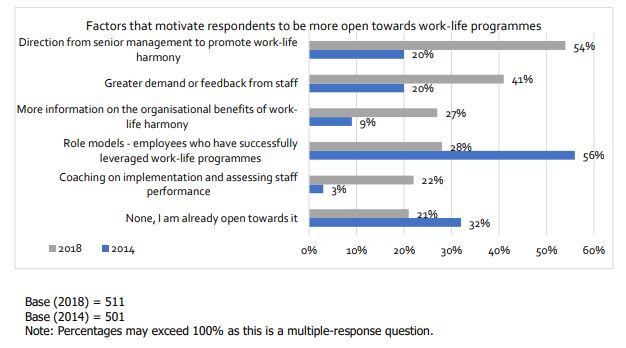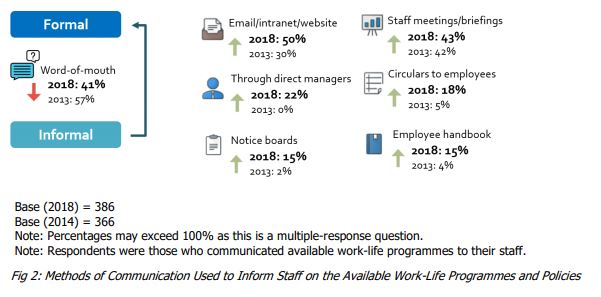Evolution of Work-Life in Singapore - The Alignment of Interests
Learn about the key shifts in the work-life landscape over the last few years.
17 Jun 2019 Articles Work-life harmony Trending Best practices Future of work

TAFEP commissioned a survey in partnership with The Straits Times (TAFEP-ST Survey) on work-life harmony and flexible work arrangements (FWAs). The survey involved 1,000 Singaporean employees and 511 employers based in Singapore. This is the second such survey being conducted; the first survey was conducted in 2014.
This article is the first of a three-part series on work-life harmony and FWAs, that shares some key findings from the TAFEP-ST Survey.
What’s good for employees is good for business…
…and employers understand this. The changing workforce landscape has shifted employers’ perceptions towards work-life programmes as well as their role in facilitating employees’ worklife harmony.
Apart from a rapidly ageing population and workforce, couples are also increasingly having smaller families, resulting in a smaller family support network and greater reliance on external childcare support such as childcare centres. Furthermore, as dual income households become the norm, the pressures to manage work responsibilities alongside household and caregiving needs is experienced by both genders.
This has urged employers to relook their organisation's work-life policies, and recognise the value of work-life programmes in managing manpower needs. Likewise, the increased pressure on caregivers who have to juggle more complex work and life responsibilities, and increased awareness of FWAs as an option to manage this, has amplified employees’ voices as their need for work-life harmony becomes more pressing.
Greater alignment between employers and employees
A key shift revealed in the TAFEP-ST Survey is the greater alignment between employers and employees based on the belief that employees should have the flexibility to manage their time and schedule as long as they are able to meet work targets and deadlines.
|
A growing number of employees also agreed that their supervisors are open towards FWAs when required.
|
This demonstrates that employers recognise that employees have responsibilities beyond the workplace and offering greater flexibility at work to enable them to better manage their work and life responsibilities. They are increasingly showing deeper commitment towards finding win-win solutions that allow their employees to contribute meaningfully at work, without having to choose between work and personal responsibilities.
Who or what is driving this change?

The survey also highlights a shift in motivating factors in becoming more open towards work-life programmes. While it might have been demand or feedback from staff that drove the implementation of work-life programmes in the past, the survey results today show that direction from senior management to promote work-life harmony in the organisation is the key factor in driving implementation. This underscores the recognition that work-life strategies are becoming a necessary employment practice; and business leaders understand that and are consciously shaping the workplaces of today.
Middle managers becoming more facilitative
As a key facilitator and enabler of work-life implementation, a growing proportion of middle managers are beginning to understand and accept the role they play in facilitating the organisation’s work-life strategy.
|
This has led to the use of more structured and intentional communication channels – the organisation work-life strategy is no longer primarily communicated via mass channels and word-of-mouth, but has become part of the department or team level communications.
This points towards a work-life strategy that is becoming increasingly embedded in the organisation’s values and culture.
For organisations striving to win the war for talent, work-life programmes are no longer a nice-to-have but a business imperative. The TAFEP-ST Survey reveals that organisations have come to terms with this and are responding by leveraging work-life programmes as a strategic attraction and retention tool.
To learn more about FWA implementation, check out these additional resources and download the Job Sharing Implementation Guide by the Ministry of Manpower and Singapore National Employers Federation.

